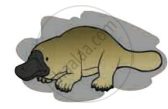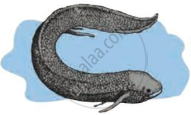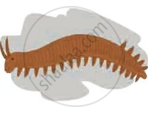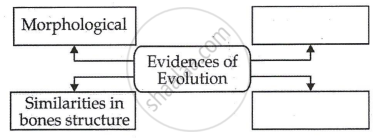Advertisements
Advertisements
प्रश्न
Define fossil.
उत्तर
Large number of organisms get buried due to disasters like flood, earthquake, volcano, etc. Remnants and impressions of such organisms remain preserved underground. These are called fossils.
APPEARS IN
संबंधित प्रश्न
What are vestigial organs?
(a) Select the homologous structures from the combinations given below:
(i) Forelimbs of whales and bats
(ii) Tuber of potato and sweet potato
(iii) Eyes of octopus and mammals
(iv) Thorns of Bougainvillea and tendrils of Cucurbita
(b) State the kind of evolution they represent.
(a) Select the analogous structures from the combination given below:
(i) Forelimbs of whales and bats
(ii) Eyes of octopus and mammals
(iii) Tuber of sweet potato and potato
(iv) Tuber of Bougainvillea and tendrils of Cucurbita
(b) State the kind of evolution they represent
Explain with an example for the given, how the following provides evidence in favor of evolution in organisms :
Homologous organs
Which of the following pairs of two vegetables represent the correct homologous structures?
(A) Sweet potato and potato
(B) Sweet potato and tomato
(C) Carrot and potato
(D) Radish and carrot
An example of homologous organs is
Explain the terms analogous and homologous organs with examples.
Find out from newspapers and popular science articles any new fossil discoveries or controversies about evolution.
Attempt giving a clear definition of the term species.
Give the importance of fossil in support of organic evolution
Explain with an example for the given, how the following provides evidence in favor of evolution in organisms :
Analogous organs
Explain with an example for the given, how the following provides evidence in favor of evolution in organisms :
Fossils
Human tailbone is a vestigial organ. Explain.
Differentiate between analogous and homologous structures.
The presence of which of the following types of organs in two organisms indicates that they are derived from the same ancestor?
(a) analogous organs
(b) respiratory organs
(c) digestive organs
(d) homologous organs
The wings of a housefly and the wings of a sparrow are an example of :
(a) analogous organs
(b) vestigial organs
(c) respiratory organs
(d) homologous organs
X, Y, and Z are three animals. The animal X can fly but animal Y can only run on ground or walls. The forelimbs of animals X and Y have the same basic design but they are used for different purposes such as flying and running respectively. The animal Z became extinct an long time ago. The study of fossils of Z tells us that it had some features like those of X and some like those of Y. In fact, Z is said to form a connecting link in the evolutionary chain of X and Y.
(a) What could the animals X, Y and Z be?
(b) What name is given to the forelimbs like those of X and Y which have the same basic design but different functions?
(c) Name one feature in which Z resembled X.
(d) Name one feature in which Z resembled Y.
(e) Which is the correct evolutionary chain involving X, Y and Z : X → Z → Y or Y → Z → X?
In a class, students were asked to observe the models/slides/pictures of the skeletons of forelimbs and wings of different organisms. After the observations the students made the following groups of homologous structures. Select the correct group :
(A) Wings of a bird and a butterfly
(B) Wings of a pigeon and a bat
(C) Wings of a butterfly and a bat
(D) Forelimbs of a cow, a duck and a lizard
What do we call the degenerated or partially developed useless organs in living organisms? Enlist such organs in human body? How the same organs are useful in other animals?
_______ is a connecting link between Annelida and Arthropoda.
The most common types of fossils are ------------------------.
Draw a labelled diagram of T.S. of a leaf showing Kranz anatomy.
What do you mean by vestigial structures? Name four vestigial organs found in man.
Differentiate between connecting links and the missing links.
Define phylogeny.
Similarities in the initial stages indicate the _______ evidence.
Find an odd one out.
Enlist the evidences of evolution.
Write the answers to the questions by observing the figure below.
 |
 |
 |
| (a) | (b) | (c) |
- Write the name of the animal ‘(a)’ in the figure.
- Write the name of the animal ‘(b)’ in the figure.
- Write the name of the animal ‘(c)’ in the figure.
- Which evolutionary evidence is illustrated by this figure?
- Write the definition of that evidence for evolution.
The fossil remains of Archaeopteryx is a connecting link between ______
Tendons and ligaments are examples of ______.
Study of fossils is ______.
Flippers of Penguins and Dolphins are examples of:
Appearance of antibiotic-resistant bacteria is an example of ______.
Did aquatic life forms get fossilised? If, yes where do we come across such fossils?
How do we compute the age of a living tree?
How do we compute the age of a rock?
While creation and presence of variation is directionless, natural selection is directional as it is in the context of adaptation. Comment.
Explain divergent evolution in detail. What is the driving force behind it?
You have studied the story of Pepper moths in England. Had the industries been removed, what impact could it have on the moth population? Discuss.
Find odd one out:
Write down the difference between homologous and analogous organs.
Explain natural selection with the example of industrial melanism.
Write a note on the significance of Palaeontology.
Complete the following conceptual picture:

Pick the odd man out:
